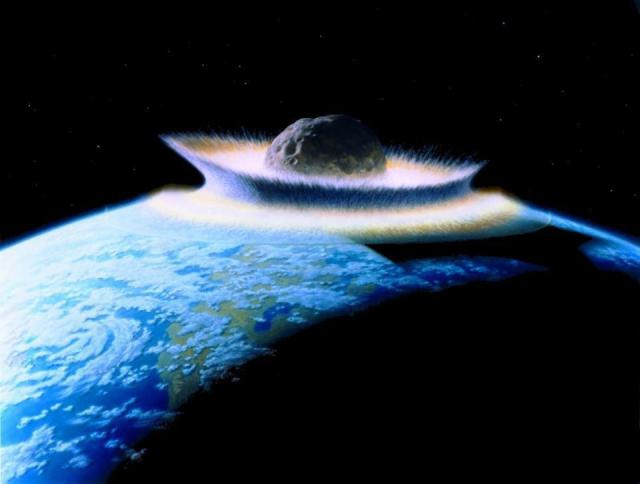#chicxulub
The Dinosaur-Killing Asteroid Acidified the Ocean in a Flash
by Lucas Joel / NY Times
What happened to the dinosaurs when an asteroid about six miles wide struck Earth some 66 million years ago in what is today Mexico is well known: It wiped them out. But the exact fate of our planet’s diverse ocean dwellers at the time, shelly ammonites, giant mosasaurs and other sea creatures, has not been as well understood.
New research now makes the case that the same incident that helped bring an end to the reign of the dinosaurs also acidified the planet’s oceans, disrupted the food chain that sustained life underwater and resulted in a mass extinction. The study, published Monday in Proceedings of the National Academy of Sciences, aims to shore up the hypothesis that the Chicxulub event’s destruction of marine life, the result of sulfur-rich rocks depositing acid rain into the oceans, was just as severe as the fire and fury it brought to land.
“It’s flash acidification, and it transformed ecosystems for millions of years,” said Noah Planavsky, a biogeochemist at Yale and one of the study’s authors. “We were shocked that we actually found this.”
The impact of the Chicxulub asteroid, so named for the crater it carved out around the Gulf of Mexico, sent columns of rock into Earth’s atmosphere, incinerated the planet’s forests and drove tsunamis far across the oceans. But the connection between the crash and the marine extinction has been less solid.
Image above © Detlev van Ravenswaay / Science Source
Post link










The Science Of Why An Asteroid, Not A Comet, Wiped Out The Dinosaurs
“The most important thing is that we all learn what the correct scientific conclusion to draw is, and why. The impact event that occurred 66 million years ago was due to an asteroid, not a comet. We know this based on many reasons, including the very compelling chemical composition of the impactor, retrieved from Chicxulub crater and matched up with the layer of ash and clay found worldwide at the appropriate depth within sedimentary rock. A comet simply has the wrong properties, and the earlier study that claimed otherwise wasn’t just in error, but contained a series of unacceptably gross errors that should have resulted in the paper’s rejection.
The larger ethical issue, however, remains unresolved. What do we do about scientists who are so full of themselves that they willfully barge into a field they have no expertise in, and rather than work to gain that expertise and contribute meaningfully, they simply publish a superficial analysis to further their own fame and careers? This sort of practice must be discouraged, the same way we discourage those with no scientific expertise from contributing nonsense: through quality peer review. The alternative is to play an unwinnable game: scientific understanding by debate and public opinion. In the enterprise of science, it must always be facts and evidence, not persuaded minds, that carry the day.”
Did you read, back in February, that a comet, not an asteroid, wiped out the dinosaurs?



DePalma began excavating systematically in 2012 and quickly found the site to contain very unusual and promising features. Everything he found had been covered so quickly that details were exceptionally well preserved, and the fossils as a whole formed a very unusual collection – fish fins and complete fish, tree trunks with amber, fossils in upright rather than squashed flat positions, hundreds or thousands of cartilaginousfullyarticulatedfreshwaterpaddlefish,sturgeon and even saltwater mosasaurs which had ended up on the same mudbank miles inland (only about four fossilized fish were previously known from the entire Hell Creek formation), fragile body parts such as complete and intact tails, ripped from the seafish’s bodies and preserved inland in a manner that suggested they were covered almost immediately after death, and – everywhere – millions of tiny spheres of glassy material known as microtektites, the result of tiny splatters of molten material reaching the ground.[5] The microtektites were present and concentrated in the gills of about 50% of the fossilized fish, in amber, and buried in the small pits in the mud which they had made when they contemporaneously impacted.[5] The fish were not bottom feeders. They had breathed in early debris that fell into water, in the seconds or minutes before death.[25] The sediment appeared to have liquefied and covered the deposited biota, then quickly solidified, preserving much of the contents in three dimensions.[25]
Later discoveries included large primitive feathers 30–40 cm long with 3.5 mm quills believed to come from large dinosaurs; broken remains from almost all known Hell Creek dinosaur groups, including some incredibly rare hatchling and intact egg with embryo fossils; fossil pterosaurs for which no other fossils exist at that time; drowned ant nests with ants inside and chambers filled with asteroid debris; and burrows of small mammals living at the site immediately after the impact.[5] Analysis of early samples showed that the microtektites at Tanis were almost identical to those found at the Mexican impact site, and were likely to be primary deposits (directly from the impact) and not reworked (moved from their original location by later geological processes).[1]
DePalma quickly began to suspect that he had stumbled upon a monumentally important and unique site – not just “near” the K-Pg boundary, but a unique killing field that precisely captured the first minutes and hours after impact, when the K-Pg boundary was created, along with an unprecedented fossil record of creatures and plants that died on that day, as well as material directly from the impact itself, in circumstances that allowed exceptional preservation.

